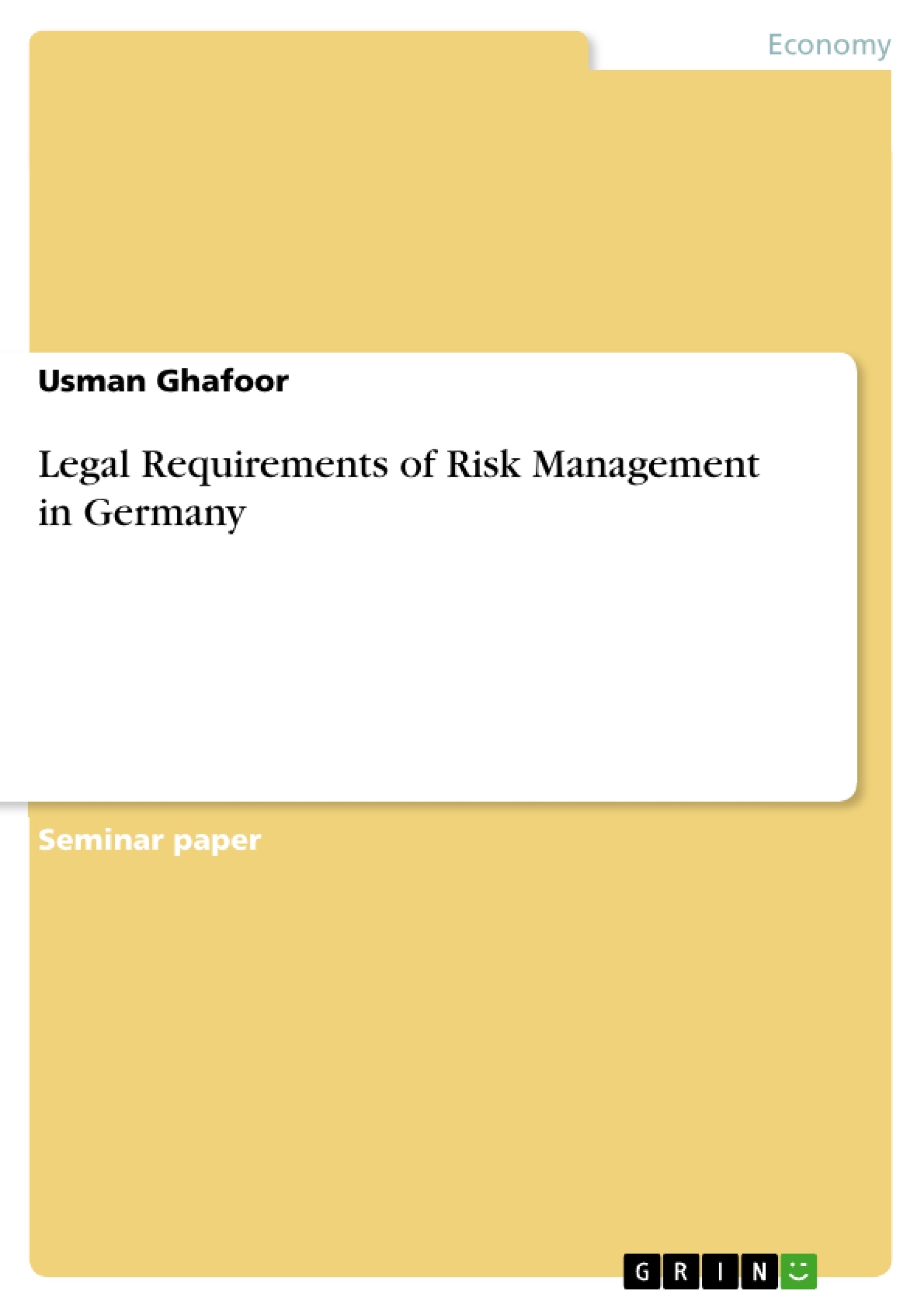The aim of this seminar paper is to illustrate the topic “Legal requirements of risk management in Germany”. An insight into the legal requirements of risk management in a company, e.g. banks and insurances, will be provided. Furthermore, a practical example of risk management at Daimler AG will be described in the following section. Finally, the paper closes with a personal conclusion.
The term “risk” is described in literature in many different ways. Risk is being described as a possible deterioration compared to an ex-pected result (loss or damage risk). According to the law “Corporate Sector Supervision and Transparency Act” it means, that a company aspires to fulfil their goals. On the way there are several factors of risk that should be taken into account. The purpose of risk management is to identify, estimate and avert possible risks during a process. Originally, big American companies created risk management out of their insurance policy. Their goal was to significantly reduce insurance premium.
Inhaltsverzeichnis (Table of Contents)
- Introduction to Risk Management
- Definition of Risk and Risk Management
- The necessity of Risk Management
- Functions of Risk Management
- Legal Requirement of Risk Management
- Corporate rules
- Corporate Sector Supervision and Transparency Act
- German Accounting Standards Committee
- Risk management in accordance with IDW PS 340
- Corporate governance rules
- German Corporate Governance Code
- Requirements for banks
- Capital Accord - Basel II
- The German Banking Act
- Minimum Requirements on Risk Management
- Solvency regulation
- Requirements for insurance
- Insurance Supervision Law (VAG)
- The scope of KonTraG to other legal forms
- Practical example of Risk Management at Daimler AG
Zielsetzung und Themenschwerpunkte (Objectives and Key Themes)
This seminar paper aims to explore the legal requirements of risk management in Germany, specifically focusing on the context of businesses, particularly banks and insurance companies. The paper provides insights into the regulatory framework and practical examples of risk management implementation. The paper concludes with a personal assessment of the topic.
- Definition and importance of risk management
- Legal requirements of risk management in Germany
- Risk management in specific sectors (banking and insurance)
- Practical application of risk management principles
- Personal assessment of the topic
Zusammenfassung der Kapitel (Chapter Summaries)
- Introduction to Risk Management: This chapter defines risk and risk management, discussing the various perspectives on the concept. It also highlights the necessity of risk management for businesses, emphasizing the potential consequences of neglecting risk management, such as bankruptcy. The chapter concludes by examining the functions of risk management and its significance in achieving business goals.
- Legal Requirement of Risk Management: This chapter delves into the legal requirements of risk management in Germany, focusing on both corporate rules and sector-specific regulations. It explores various acts, regulations, and guidelines related to risk management, such as the Corporate Sector Supervision and Transparency Act, German Accounting Standards, IDW PS 340, and the German Corporate Governance Code. This chapter also examines regulations specific to banks, including the Capital Accord - Basel II, the German Banking Act, minimum requirements for risk management, and solvency regulations. Finally, it discusses the requirements for insurance companies, specifically referencing the Insurance Supervision Law (VAG).
- The scope of KonTraG to other legal forms: This chapter examines the applicability of the Control and Transparency in Business Act (KonTraG) to legal forms other than corporations. It explores the extent to which the act's provisions regarding risk management apply to various business structures. This chapter analyzes the interplay between KonTraG and other legal frameworks.
- Practical example of Risk Management at Daimler AG: This chapter provides a real-world case study of risk management in action. It presents a practical example of how risk management is implemented at Daimler AG, a major German automotive company. The chapter analyzes Daimler AG's risk management approach and how it aligns with the legal and regulatory frameworks discussed earlier in the paper.
Schlüsselwörter (Keywords)
The core concepts and topics explored in this seminar paper include risk management, legal requirements, corporate governance, banking regulations, insurance supervision, KonTraG, German Accounting Standards, IDW PS 340, Basel II, and practical application of risk management principles.
- Arbeit zitieren
- Usman Ghafoor (Autor:in), 2016, Legal Requirements of Risk Management in Germany, München, GRIN Verlag, https://www.hausarbeiten.de/document/317912


